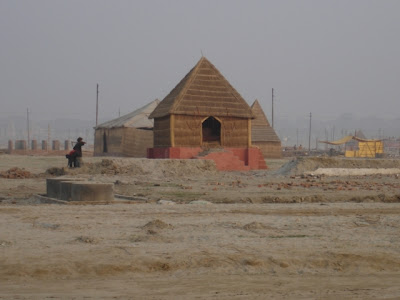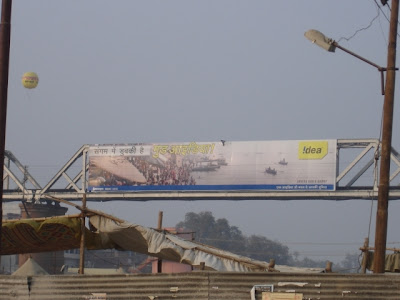
This is a view of a small portion of the Kumbh Nagari at night. All the Akharas and other tents are gone. The lights seen here are only the street lights for the kilometres of roads that are built all over the riverbed. This riverbed lies on the other side of an earthen dam, and as one walks up the dam from the other side, the whole thing jumps into view at once. One second you see empty space in front, and the next second you see a galaxy of lights stretching as far as you can see. It is an indescribable experience.
This is one of the steel plates used to build those miles and miles of roads. These are needed so that the vehicles don’t get stuck in the sand. These will be removed after most other things have been removed. I have seen camels being used to do the leftover work after that. I once saw these roads being laid and found that these steel plates are so heavy that a dozen men are required to lift each one. The section of the road shown here is actually on a floating pontoon bridge. The pontoons can be glimpsed at the top right corner. Many such bridges were built across the Ganga.

These are the wooden mazes made on the Mela grounds so that the crowd is forced to follow an elongated path while walking towards the bathing area. This is necessary in order to prevent stampedes.

This view of the Mela ground shows that most of the tents are gone. A couple of small hut-like ones are still standing.
It’s not only the tents that have to be taken down and carried away. As can be seen in this photo, these people have the mammoth task of counting and packing up the huge cooking utensils and gas stoves that were used to cook the daily meals for thousands of people.
There’s a difference in the Mela this year. The little boys and girls running all over the grounds picking rags have come to recognize a digital camera by sight. So I was often pestered by them to take a photo while they posed, and show it to them on the screen immediately afterwards. They know that I’ll delete it immediately afterwards, yet their only joy lies in seeing themselves in that tiny LCD screen.

If you notice the previous picture carefully, you’ll see that a railway bridge behind the boy has been covered in advertisements. A close up of one of the sections shows how the Mela is used as a big publicity tool by the companies. An advertising baloon is also visible in the distance. This is called religious marketing!

As I wandered about, I came across this man. They are a team of three. This man carries the loudspeakers used for announcements all over the Mela, while his colleague (shown below) climbs the poles and takes them down. Then he also uproots the poles which are carried away in another tractor standing alongside.

Before I returned, I stopped on the dam for taking the first photo of this post. A group of army men on Mela duty were sitting nearby. One of them told me, “Why don’t you climb our watchtower? You’ll get a better view from up there.” He was talking about the elevated wooden platform that had been erected nearby for these army men to keep watch (it can be seen silhouetted on the extreme right of my first photo). I promptly clambered up on to the platform and took some photos from up there as well, though they were hardly better.
And thus a city built over two months is dismantled. A tiny part of this will be rebuilt for the Magh Mela next January, but for the real thing we'll have to wait for another six years.



Sugata,
ReplyDeleteI like your photojournalistic way of putting up the information. It's so informative!
Nice information accompanied by appropriate images! I loved the night shot very much.
Thanks fr sharing...:-)
me too!!
ReplyDeletethe nite-shot was really too gud.
darun hoyechhe. Sadharanato sabai garar katha e lekhe, bhangar byapartao je dekhar mato r anubhab karar mato, ta tumi bujhechho, tomar mon achhe. Photo gulo khub bhalo hoechhe. Lage raho....
ReplyDeleteGood to see the pics as I couldn't make it there in midst of all the other traveling. May be in a 6 years time.
ReplyDeleteIt was sooo good!! kemon aachho?
ReplyDelete@abhijit: Thanks. I took inspiration from the National Geographic articles where they have only the photos and accompanying descriptions, nothing else.
ReplyDelete@aurindam: Thanks. It was difficult without a tripod.
@pisimoni: Garhar samaye to thakte parini, tai bhangar oporei likhte holo.
@shreemoyee: Better luck next time!
@anonymous: Thanks, bhalo achhi. Do I know you?
Thanks for this detailed info with photos. But you did not make any comments whether we need this kind of expenditure, when it is needed for something else. Don't you feel this is too much? I request your views.
ReplyDelete@nikheel shaligram: I do not understand your point. Why do you think this expenditure is unnecessary?
ReplyDelete